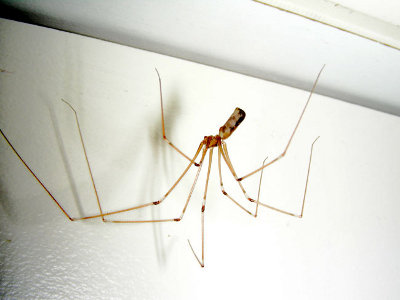Daddy Long Legs Spider
Category: Arachnida Spider

Facts about Daddy Long Legs Spiders, "Scientific name for Daddy Long Legs Spider is Pholcus phalangoides". Daddy long legs spiders are effectively perceived by their amazingly long, thin legs and little body. They are cream to pale tan. A few of the Daddy Long Legs Spider varieties have darker markings on their legs and belly.
The Daddy Long Legs Spider can reach 9 mm in size
The Daddy long legs Spider, is found all through the world. They live on every continent except Antarctica. It is a cosmopolitan animal groups that begins from Europe and was brought accidentally into Australia and other countries.
Territory of Daddy Long Legs Spiders
Daddy long legs Spiders are found in most urban territories, specifically houses. They make a slight, tangled web in protected positions were they are unrealistic to be irritated, for example, under furniture, behind entryways, in the corner of the roofs, in sheds, in carports and under decks. Its fruitful utilization of these human made structures has made Daddy Long Legs Spiders a standout amongst the most widely recognized insects in the world. In the event that the Daddy long legs Spider is irritated in the web it reacts by setting up a quick, turning movement, turning into an obscure to anybody viewing.
Daddy Long Legs Spiders have oversize brains.
In the Daddy Long Legs Spider the oxygen is bound to "hemocyanin" a copper-based protein that turns their blood blue, a molecule that contains copper rather than iron. Iron-based hemoglobin in red blood cells turns the blood red.
A Daddy Long Legs Spiders stomach can only take liquids, so a spider needs to liquefy their food before they eat. They bite on their prey and empty its stomach liquids into the pray which turns it into a soup for them to drink.
A male Daddy Long Legs Spider has two appendages called "pedipalps" a sensory organ, instead of a penis, which is filled with sperm and insert by the male into the female Daddy Long Legs Spider’s reproductive opening.
Daddy long legs insects are the basic house spider, which could be effortlessly recognized by their outstandingly long legs, as contrasted with the measure of their body. They fit in with the family, Pholcidae, which holds something like 80 genera and 1000 species. Out of these, the most well known species is the Pholcus phalangioides, which is ordinarily known as daddy long legs creepy crawly or basement insect. The term, 'daddy long leg', is likewise usually utilized for crane flies, which are really creepy crawlies in the family, Tipulidae.
Notwithstanding crane flies, an alternate species that is frequently alluded as daddy long legs, is the as far back as anyone can remember legged harvestmen. Harvestmen are 8 legged creatures, however not insects, and they might be recognized from daddy long legs insect by the structure of their body. They have one and only body area, also. their midriff and cephalothorax are combined to structure one structure. Yet, daddy long legs spiders have different belly and cephalothorax. This insect is otherwise called vibrating creepy crawly, granddaddy long legs bug, house arachnid, or daddy long legger.
Peril to people and medical aid. There is a persevering conviction that the Daddy long legs Spider has the most poisonous venom of all spiders. Be that as it may, there is no investigative proof to back this up. The myth presumably developed from perceptions that the Daddy long legs Spider will slaughter and consume a Redback Spider. Nonetheless, the venom is not really that powerful, compared to other spiders.
It had been suspected that the fangs of the daddy long legs were unequipped for penetrating human skin. As of late, notwithstanding, it was demonstrated that the small fangs (something like 0.25 mm) were really fit for penetrating human skin in a test done on the US TV program, Mythbusters, however the stinging sensation delivered was brief. Most legitimate sources, including the University of California, Riverside, still say that this species would never be considered as destructive to people. Then again, in the impossible occasion of a nibble from this animal groups, a positive recognizable proof of the arachnid by a master ought to be made and medicinal consideration looked for if any response endures for more than a brief time.

 Back To Category Arachnida Spider
Back To Category Arachnida Spider